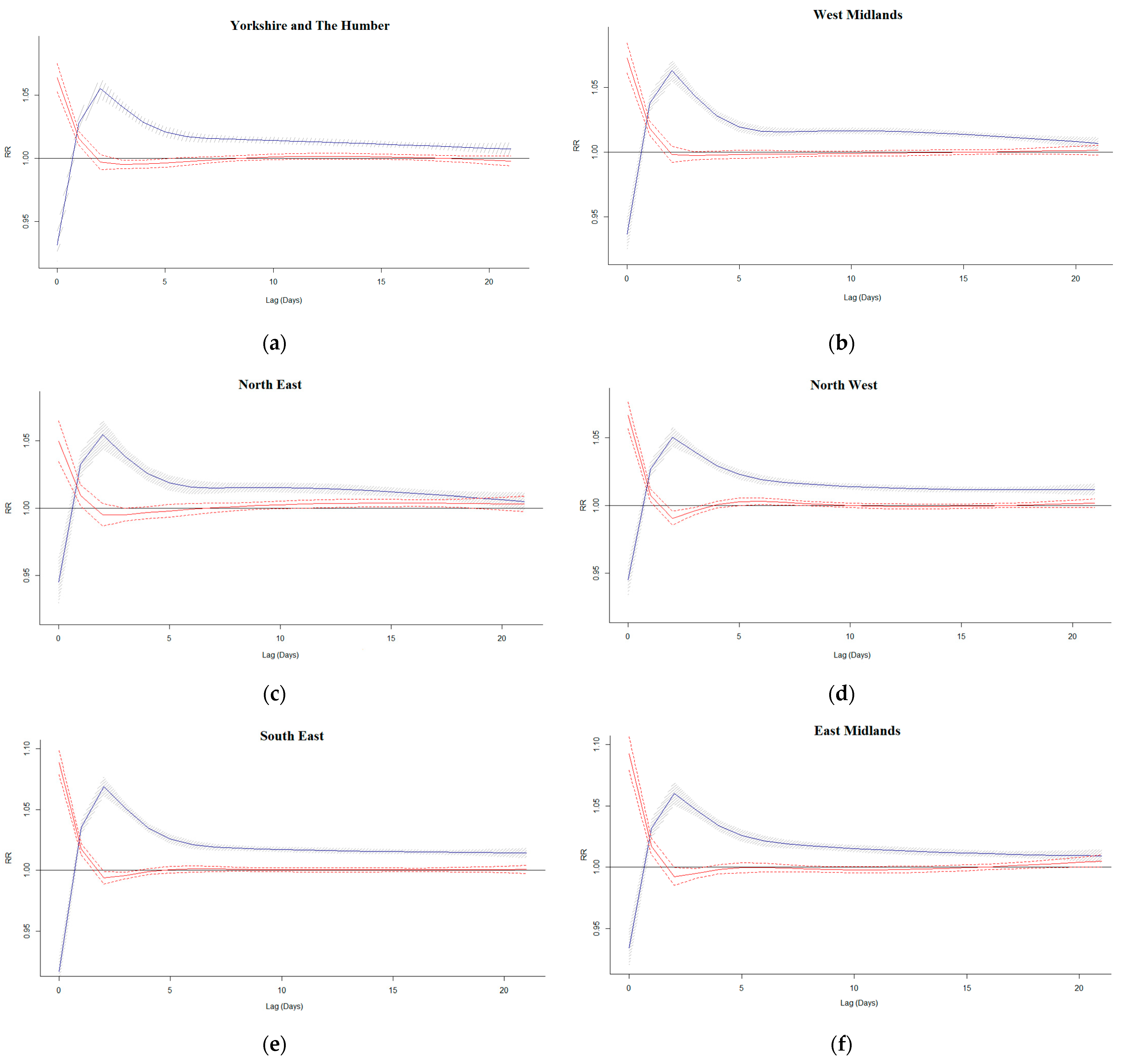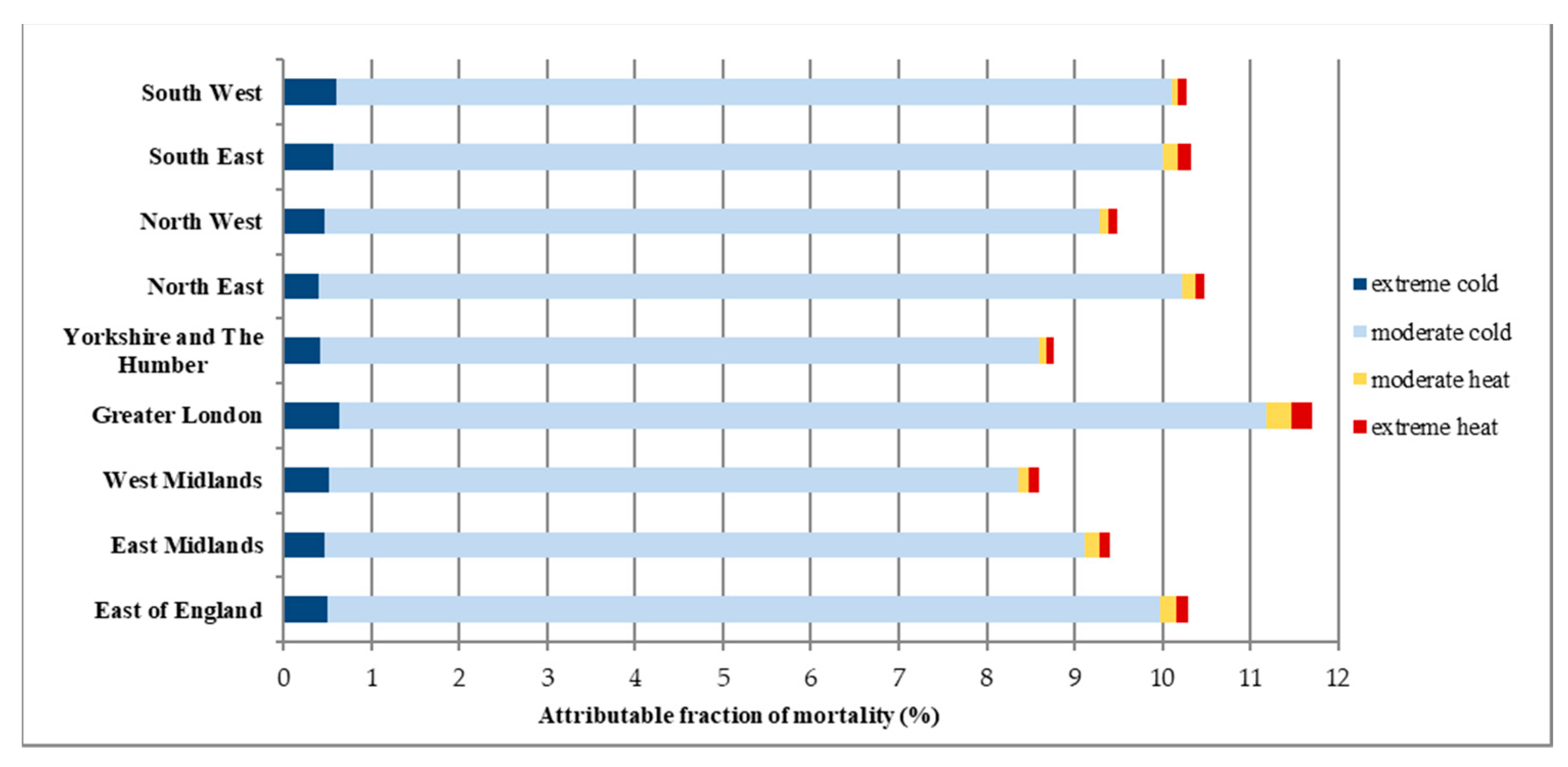The Effect of Apparent Temperature on All-Cause Mortality in England, UK †
Abstract
:1. Introduction
2. Materials and Methods
2.1. Study Area and Data Resources
2.2. Apparent Temperature
2.3. Statistical Analysis
3. Results and Discussion
4. Conclusions
Author Contributions
Funding
Institutional Review Board Statement
Informed Consent Statement
Data Availability Statement
Acknowledgments
Conflicts of Interest
References
- Gasparrini, A.; Guo, Y.; Hashizume, M.; Kinney, P.L.; Petkova, E.P.; Lavigne, E.; Zanobetti, A.; Schwartz, J.D.; Tobias, A.; Leone, M.; et al. Temporal Variation in Heat–Mortality Associations: A Multicountry Study. Environ. Health Perspect. 2015, 123, 1200–1207. [Google Scholar] [CrossRef] [PubMed]
- Gasparrini, A.; Masselot, P.; Scortichini, M.; Schneider, R.; Mistry, M.N.; Sera, F.; Macintyre, H.L.; Phalkey, R.; Vicedo-Cabrera, A.M. Small-Area Assessment of Temperature-Related Mortality Risks in England and Wales: A Case Time Series Analysis. Lancet Planet. Health 2022, 6, e557–e564. [Google Scholar] [CrossRef]
- Hajat, S. Health Effects of Milder Winters: A Review of Evidence from the United Kingdom. Environ. Health 2017, 16, 109. [Google Scholar] [CrossRef]
- Psistaki, K.; Dokas, I.M.; Paschalidou, A.K. The Impact of Ambient Temperature on Cardiorespiratory Mortality in Northern Greece. Int. J. Environ. Res. Public Health 2022, 20, 555. [Google Scholar] [CrossRef]
- Psistaki, K.; Dokas, I.; Paschalidou, A. Analysis of the heat- and cold-related cardiovascular mortality in an urban Mediterranean environment through various thermal indices. Environ. Res. 2023, 216, 114831. [Google Scholar] [CrossRef]
- Silveira, I.H.; Oliveira, B.F.A.; Cortes, T.R.; Junger, W.L. The Effect of Ambient Temperature on Cardiovascular Mortality in 27 Brazilian Cities. Sci. Total. Environ. 2019, 691, 996–1004. [Google Scholar] [CrossRef] [PubMed]
- Fu, S.H.; Gasparrini, A.; Rodriguez, P.S.; Jha, P. Mortality Attributable to Hot and Cold Ambient Temperatures in India: A Nationally Representative Case-Crossover Study. PLoS Med. 2018, 15, e1002619. [Google Scholar] [CrossRef]
- Son, J.-Y.; Liu, J.C.; Bell, M.L. Temperature-Related Mortality: A Systematic Review and Investigation of Effect Modifiers. Environ. Res. Lett. 2019, 14, 073004. [Google Scholar] [CrossRef]
- Steadman, R.G. A Universal Scale of Apparent Temperature. J. Appl. Meteorol. Climatol. 1984, 23, 1674–1687. [Google Scholar] [CrossRef]
- Gasparrini, A.; Armstrong, B.; Kenward, M.G. Distributed Lag Non-Linear Models. Statist. Med. 2010, 29, 2224–2234. [Google Scholar] [CrossRef]



| Minimum Mortality Temperature (MMAT, °C) | Minimum Mortality Percentile (MMP) | Relative Risk for Extreme Cold (95% CI) | Relative Risk for Extreme Heat (95% CI) | Relative Risk for Moderate Cold (95% CI) | Relative Risk for Moderate Heat (95% CI) | |
|---|---|---|---|---|---|---|
| Yorkshire and The Humber | 14.6 | 93 | 1.34 (1.29–1.39) | 1.07 (1.03–1.10) | 1.16 (1.13–1.20) | 1.00 (1.00–1.01) |
| Greater London | 17.2 | 90 | 1.49 (1.44–1.54) | 1.18 (1.14–1.21) | 1.24 (1.21–1.27) | 1.00 (1.00–1.00) |
| East England | 15.5 | 91 | 1.43 (1.37–1.48) | 1.12 (1.08–1.16) | 1.20 (1.16–1.24) | 1.00 (1.00–1.00) |
| East Midlands | 14.9 | 91 | 1.40 (1.34–1.46) | 1.10 (1.05–1.14) | 1.20 (1.16–1.25) | 1.00 (1.00–1.00) |
| West Midlands | 15.2 | 91 | 1.40 (1.35–1.46) | 1.08 (1.05–1.12) | 1.17 (1.14–1.21) | 1.00 (1.00–1.00) |
| North East | 12.9 | 91 | 1.35 (1.28–1.42) | 1.09 (1.04–1.14) | 1.21 (1.16–1.26) | 1.00 (1.00–1.00) |
| North West | 14.5 | 92 | 1.37 (1.33–1.42) | 1.07 (1.05–1.10) | 1.19 (1.16–1.22) | 1.00 (1.00–1.00) |
| South East | 15.9 | 91 | 1.47 (1.42–1.51) | 1.11 (1.08–1.13) | 1.21 (1.18–1.24) | 1.00 (1.00–1.00) |
| South West | 15.6 | 92 | 1.50 (1.44–1.55) | 1.06 (1.03–1.09) | 1.21 (1.17–1.25) | 1.00 (1.00–1.00) |
Disclaimer/Publisher’s Note: The statements, opinions and data contained in all publications are solely those of the individual author(s) and contributor(s) and not of MDPI and/or the editor(s). MDPI and/or the editor(s) disclaim responsibility for any injury to people or property resulting from any ideas, methods, instructions or products referred to in the content. |
© 2023 by the authors. Licensee MDPI, Basel, Switzerland. This article is an open access article distributed under the terms and conditions of the Creative Commons Attribution (CC BY) license (https://creativecommons.org/licenses/by/4.0/).
Share and Cite
Psistaki, K.; Paschalidou, A.K. The Effect of Apparent Temperature on All-Cause Mortality in England, UK. Environ. Sci. Proc. 2023, 26, 148. https://doi.org/10.3390/environsciproc2023026148
Psistaki K, Paschalidou AK. The Effect of Apparent Temperature on All-Cause Mortality in England, UK. Environmental Sciences Proceedings. 2023; 26(1):148. https://doi.org/10.3390/environsciproc2023026148
Chicago/Turabian StylePsistaki, Kyriaki, and Anastasia K. Paschalidou. 2023. "The Effect of Apparent Temperature on All-Cause Mortality in England, UK" Environmental Sciences Proceedings 26, no. 1: 148. https://doi.org/10.3390/environsciproc2023026148
APA StylePsistaki, K., & Paschalidou, A. K. (2023). The Effect of Apparent Temperature on All-Cause Mortality in England, UK. Environmental Sciences Proceedings, 26(1), 148. https://doi.org/10.3390/environsciproc2023026148







